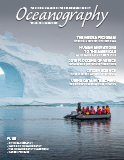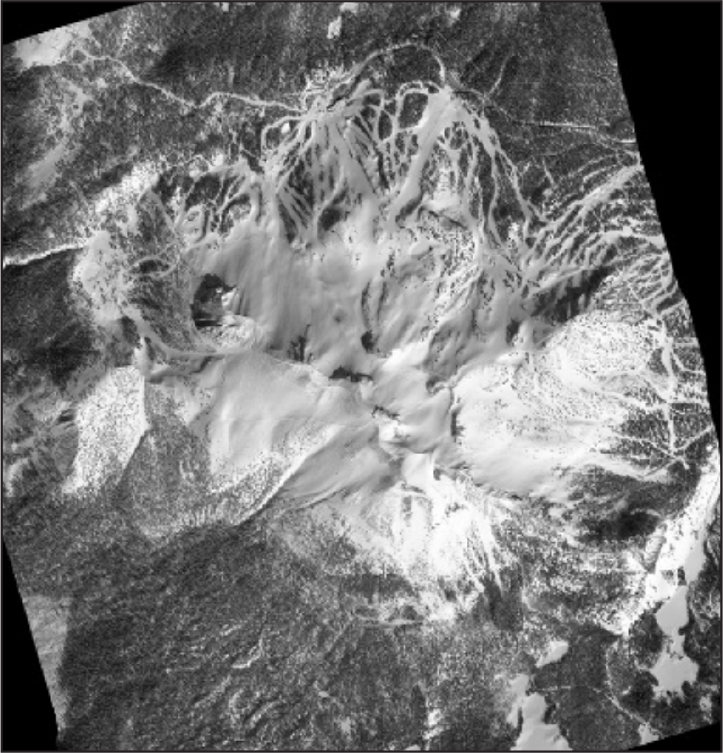THE STAGE IS SET
Oceanography and sister Earth science disciplines have always been data poor. And intelligence agencies by definition don’t share the data they collect. But the MEDEA program, launched in 1992, brought these communities together and provided new insights and a quantum leap in the amount of data available. We write this article having had the privilege of participating in the development of MEDEA from its beginning to its conclusion.
To understand how this collaboration came about, we go back to 1960. At that time, the US National Reconnaissance Office (NRO) began flying photoreconnaissance (spy) satellites in response to a growing desire of the US Intelligence Community for detailed photographic coverage of countries behind the iron curtain (Ruffner, 1995). Global data over countries of interest were collected, but by law, no data were collected over the United States. For an early history of the program, see Burrows (1987) and Richelson (1990). Civilian scientists coveted those data from the very beginning, but they remained behind closed doors. In 1978, President Jimmy Carter, on the advice of Science Advisor Frank Press, asked the Central Intelligence Agency (CIA) to set up a task force on declassification. But the agency decided that the time was not right, and no data were released (CIA, 1979).
It was not until the early 1990s that real progress was made. In 1990, then Senator Al Gore asked the CIA and the NRO to consider releasing environmental information gleaned from classified data in a way that national security would not be compromised. Gore wanted to augment civilian programs in Earth sciences and continued over the next two years to pursue his idea. At the same time, as the Cold War wound down, the CIA under Director Robert Gates was assessing new roles and missions for US intelligence in a post-Cold War world. Finally, in January 1992, the response from the CIA was cautiously positive, as Gates wrote to Gore saying, “I share your concern that we need to do more in this important area, and perhaps intelligence can play a greater role in the future.” In October 1992, a CIA-sponsored Environmental Task Force (ETF) was commissioned to conduct the first post-Cold War review of classified systems, data, and archives for their value in increasing our understanding of global climate change and other key environmental issues. At the same time, a Classification Review Task Force was established to consider the declassification of satellite imagery from the earliest reconnaissance systems.
Author Zall, as a CIA Officer, was tasked by DCI Gates to review the classified systems to see if there was useful environmental information that might be released. Zall sought advice from the outside scientific community, bringing in Jeff Dozier, later co-chair of the ETF along with author Baker and Gordon MacDonald, to examine the data. The conclusion from their work and the two task forces was that the imagery collected by the first group of satellites flown in the 1960s offered unusual and valuable information for scientists, scholars, and historians. The timing was propitious, because in 1992 the Department of Defense had publicly acknowledged the existence of the National Reconnaissance Office (Berkowitz, 2011).
FORMATION AND SCOPE OF THE MEDEA PROGRAM
To implement the program, a group of about 70 scientists covering the major branches of environmental science made up the ETF. The members were each given a high-level security clearance so that they could understand satellite technology, orbits, sensors, and calibration, and could analyze the kinds and locations of data being collected. In late 1993, Gore, now Vice President, arranged with the CIA to establish the ETF as a permanent advisory group (Figure 1), and the group was renamed MEDEA. The name MEDEA was chosen, not as an acronym, but to complement the name of another government advisory group, JASON, whose name had come from the Greek myth of Jason, Medea, and the Argonauts. Gordon MacDonald initially chaired the group, succeeded by Michael McElroy in 1995. MEDEA worked through subject matter panels: Ocean Productivity, Circulation, Air-Sea Exchange; Clouds, Radiation, Water Vapor, and Precipitation; Geology, Volcanoes, and Solid Earth; Polar Ice Sheets, Permafrost, and Sea Level; Greenhouse Gases and their Atmospheric Transformations; Land Cover and Primary Productivity; Land Use, Population Dynamics, and Economics and Urban Development; Environmental Applications; Sensor Characteristics; and Data Systems. In 1993, a Government Applications Task Force made up of 13 agencies with Earth science data interests documented civil agencies’ environmental data needs and assessed the potential of US national security assets to contribute to those needs. See Richelson (1998) and Brumfiel (2011) for a brief history of the program.

Figure 1. MEDEA group meeting with Vice President Al Gore in the Old Executive Office Building, May 14, 1996, to discuss Arctic and Antarctic science issues and data release. Walter Munk is in the white coat directly across from the Vice President, Secretary of the Interior Bruce Babbitt, and Science Advisor Jack Gibbons. On Walter’s left, Robert Bindschadler. On his right, Michael McElroy, Linda Zall, Norbert Untersteiner, and Gordon MacDonald. In rear to right, Darrell Herd and Jay Zwally. At projector, Craig Chellis. > High res figure
|
As a result of the initial work of MEDEA, President Bill Clinton signed a historic Presidential Executive Order (Clinton, 1995) on February 22, 1995, releasing more than 800,000 images from the earliest spy satellites (Broad, 1995). This was one of the largest declassification projects in US history. MEDEA ensured transfer of the full imagery archive to public archives at the National Archive and Records Administration (NARA) and the Earth Resources Observation Systems (EROS) Data Center. At MEDEA’s urging, the Intelligence Community later declassified thousands more higher resolution images from later intelligence satellites. Since the US reconnaissance imagery was first collected in 1960, coverage over a period of 12 years was instantly added to the civilian Landsat data collection that began in 1972. In addition, at the request of VADM Paul Gaffney, MEDEA assessed key historical data holdings held by the US Navy for its value to environmental and climate change science. At the recommendation of MEDEA, in 1995 the Navy made available significant amounts of both previously declassified data and other data not previously released.
MEDEA continued to have White House support for its work during the Clinton Administration, but the project was terminated in 2001. It began again in 2008 with the help of Senator Dianne Feinstein and lasted until 2015 (Broad, 2010). This time, Ralph Cicerone, President of the National Academy of Sciences, chaired the new group of 45 environmental scientists (Figure 2). One of the MEDEA’s branches, The Global Fiducials Program (a set of fixed points of reference), has continued to collect data since the beginning of the program.
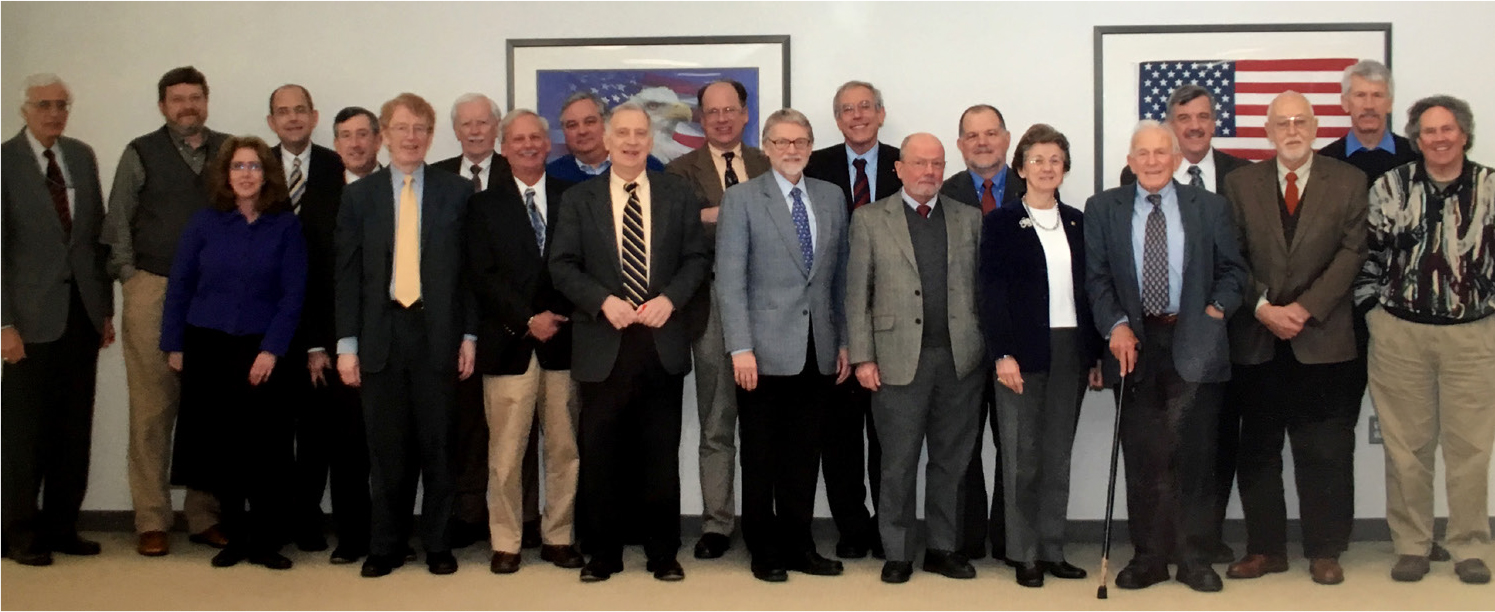
Figure 2. Key members of MEDEA as reconvened in 2008. From left: Robert Winokur, Ray Kreig, Linda Zall, Darrell Herd, Paul Gaffney, Michael McElroy, James Devine, Doug Way, Hank Shugart, Ralph Cicerone, William Schlesinger, D. James Baker, Peter Jutro, Tom McCord, Otis Brown, Rita Colwell, Walter Munk, John Orcutt, Nobert Untersteiner, Robert Bindschadler, and Jeff Dozier. > High res figure
|
TECHNICAL ISSUES AND LIDPs
Collection of useful environmental data from classified satellite imagery and making it available for unclassified use was not an easy task. The collection systems were optimized for specific locations of near-term targets of intelligence interest, not long-term environmental change. Moreover, the high-resolution images collected by the intelligence systems (Literal Image Products) had to be downgraded to 1 m resolution in order to be released. In 1995, the MEDEA program supported the development of complex new engineering technology to ensure that the released images could not be brought back to the original higher resolution (Director of National Intelligence, 2014). The final declassified images, Literal Image Derived Products (LIDPs), were then made available to the MEDEA scientists for use in unclassified work and later were released broadly to the scientific community.
Much of the imagery collected for intelligence and for military targets was not useful for monitoring environmental change. In 1992, Walter Munk summarized the ETF’s needs to author Zall by saying: “It’s well and good to show us images of the targets you have, but if you want me to evaluate them for oceanography, I need to see images collected over the oceans. And I know the others feel the same, the foresters, ecologists, polar scientists, and so on.” To meet this need, the Intelligence Community agreed to collect about 1,800 new and unprecedented images over what came to be called “non-traditional targets.” These images were aimed at showing, for example, landscape and ecosystem changes, movements of Arctic Ocean sea ice, Antarctic ice sheets, glacier mass balance, equatorial mountain snow cover, permafrost, deforestation, desertification, volcano monitoring, and carbon mass balance. These images were classified and at that point in time were only available for review by the cleared ETF scientists, but they were critical for assessment of the value of the data.
With MEDEA’s later urging, by 1999 the Intelligence Community had declassified and released to the public thousands of the LIDPs, augmenting the older imagery released through President Clinton’s 1995 Executive Order. These LIDPs helped scientists leverage existing and publicly available data provided by unclassified civil and commercial satellite systems. The result was an explosion of new information confirming and extending our understanding of global climate change. Figure 3 shows an example of the LIDPs made available—Mammoth Mountain in California, one of the sites chosen to represent seasonal snow. This and similar images have been used to assist in the retrieval of snow cover information from sensors with coarser resolution carried by Landsat and other satellite system (Jeff Dozier, UC Santa Barbara, pers. comm., 2020). Along with the historic spy satellite data, these images are available today from the US Geological Survey under the headings Declassified Data and Global Fiducials (https://earthexplorer.usgs.gov/).
Figure 4 shows a good example of the way the declassified imagery could extend a time series. It compares images of the Aral Sea in 1962 and 1994. The 1962 image was declassified from the first US reconnaissance program, CORONA (CIA, 2012; see also Ruffner, 1995, and https://en.wikipedia.org/wiki/Corona_(satellite)). Both images have been scaled to cover the same geographic area (note the same locations of the bright land features in both) and show clear differences in the extent of Aral Sea waters. The shrinkage over a 58-year period as water is reallocated for irrigation is evident (https://earthobservatory.nasa.gov/world-of-change/AralSea). This was one of the first demonstrations of the striking changes that could now be documented.
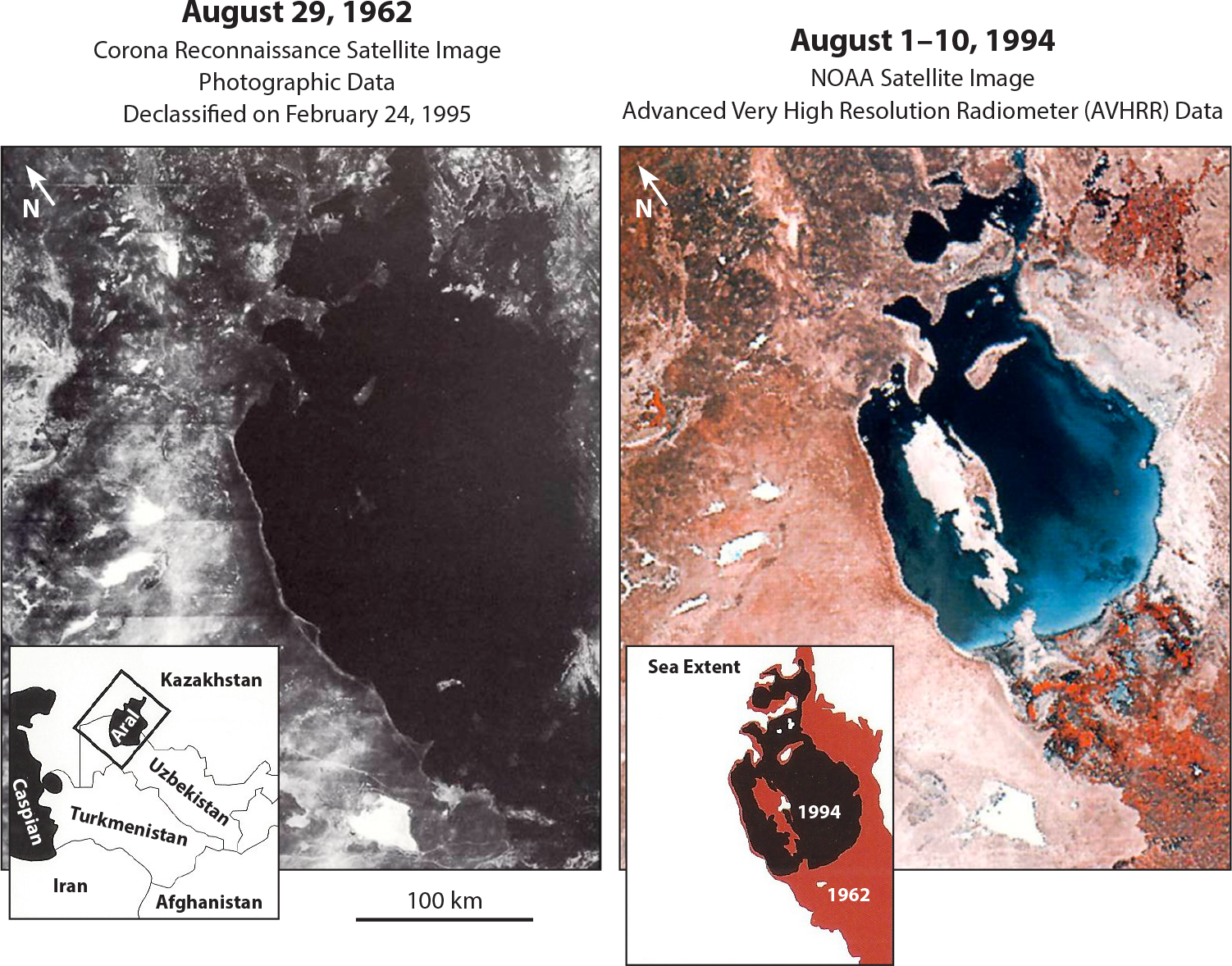
Figure 4. Images of the Aral Sea, on the left from a previously classified set of CORONA images (Vande Castle, 2001); on the right from NOAA’s AVHRR Radiometer (see https://www.nesdis.noaa.gov/search/content/aral sea for latest information). These images illustrate the significant shrinkage of the Aral Sea from 1962 to 1994. This pair of images was created by the CIA for the announcement of the Presidential Executive Order releasing CORONA and other imagery to the public (Clinton, 1995). > High res figure
|
GLOBAL FIDUCIALS PROGRAM
In addition to simply using single images of opportunity, the MEDEA scientists wanted systematic time series over areas potentially indicative of global change. The CIA agreed to take on a limited set of tasks for the classified satellites to systematically image, store, and eventually declassify information from specific areas around the world that would provide a record for current and future Earth scientists. The locations chosen are called fiducial points, geographic locations that serve as benchmarks for long-term monitoring of global environmental change. MEDEA’s Global Fiducials Program initially identified 500 sites worldwide (see Figure 5) and collected and archived more than 20,000 electro-optical images from those sites (Dozier, 1997; Molnia et al., 2018). Examples of change detection include snow and ice retreat (Kwok and Rothrock, 2009), coastal sea level rise (Molnia et al., 2019), and vegetation change (Schlesinger and Gramenopoulos, 1996; Shugart et al., 2001).
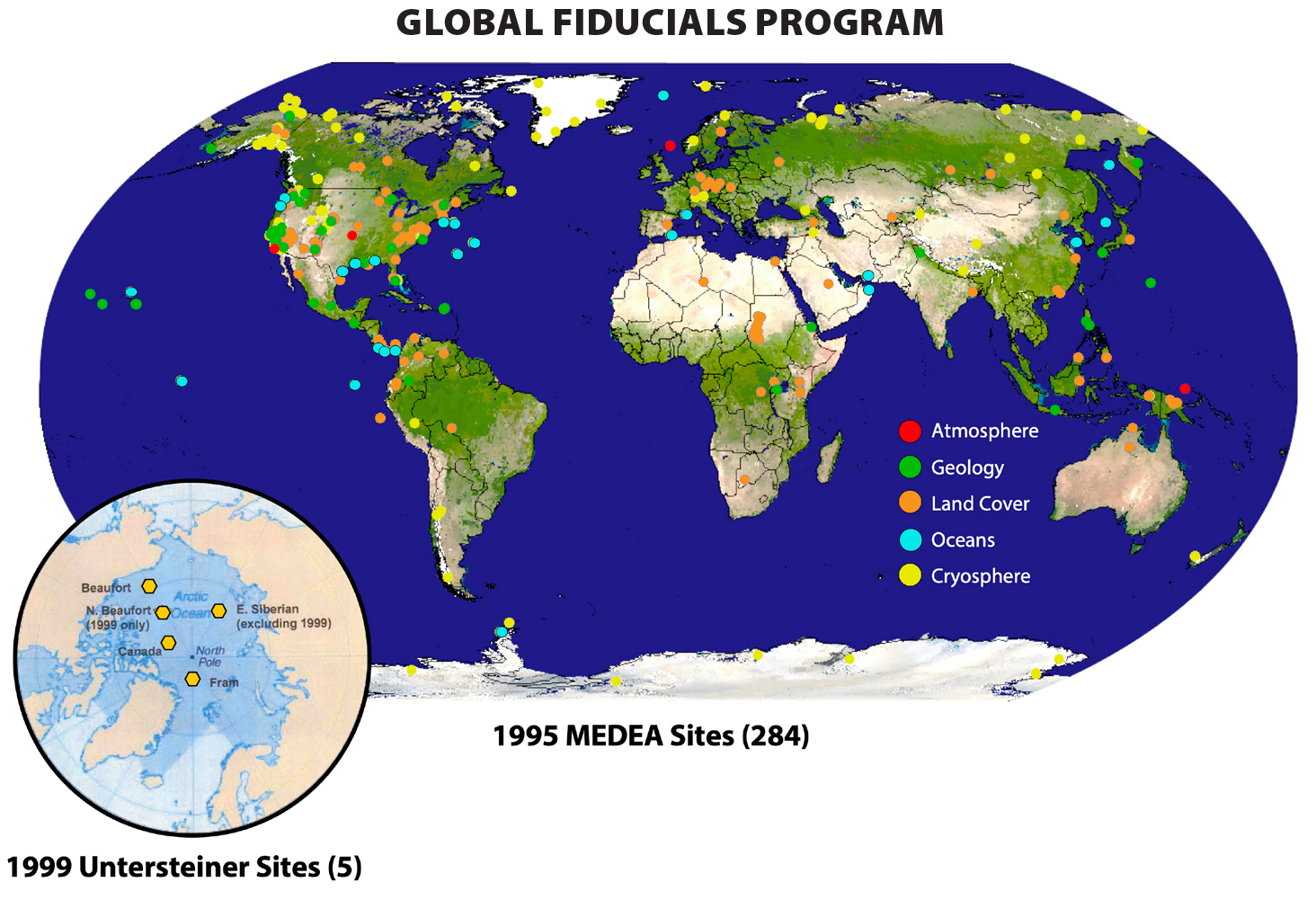
Figure 5. MEDEA fiducial locations, fixed points of reference that cover all topics (Zall, 2008). The inset shows the five fiducial locations that were used in the Arctic Ocean. > High res figure
|
A surprising development came about related to the Global Fiducials Program. Recognizing the possibility that the Arctic basin might become seasonally ice-free, the MEDEA program, at the request of University of Washington polar-science pioneer Norbert Untersteiner, had started collecting overhead classified imagery of sea ice at several sites in 1999. When the MEDEA program and associated CIA funding were terminated in 2000, it was thought that the Global Fiducials Program had been stopped as well. In fact, Untersteiner discovered that the satellite tasking had not been turned off! The Intelligence Community had continued to collect thousands of high-resolution images for MEDEA for eight years beyond the termination date.
When MEDEA started again in 2008, there were thousands of images from those sites. Initially, several hundred unclassified LIDPs with a nominal resolution of 1 m had been derived from the original classified images collected at Arctic sites. To underscore the importance of continuing this collection beyond that original set, a report from the Polar Research Board of the National Academy of Sciences emphasized the scientific value of Arctic sea ice imagery-derived products by showing the unique detailed information they could contribute to the scientific discussion (NRC, 2009). As of 2012, close to 3,000 images had been collected, processed, declassified, and released. To guide future monitoring, a MEDEA-sponsored report, Monitoring Climate Change Impacts: Metrics at the Intersection of Human and Earth Systems (NRC, 2010a), presented an illustrative set of metrics that are likely to be affected by climate change and that could potentially give advance warning of climate-related changes to the human and environment systems.
Ice Stream and Glacier Movement
One of the first uses of the newly released fiducial data was related to ice movement and glacial flow. Two images from the Global Fiducials Library, seven years apart, document the changes (Figure 6). Bindschadler and Vornberger (1998) used similar data to show how the boundaries of fast-moving ice streams of the West Antarctic Ice Sheet changed over time in the Ross Ice Shelf area. The variation had been suggested based on physical considerations but was doubted by many experts until the newly declassified data showed actual evidence. The fiducials program also allowed scientists to follow glacier retreat. For example, Shuchman et al. (2010) used the new data to track changes in the Bering Glacier as it retreated about 6 km from 1995 to 2006.
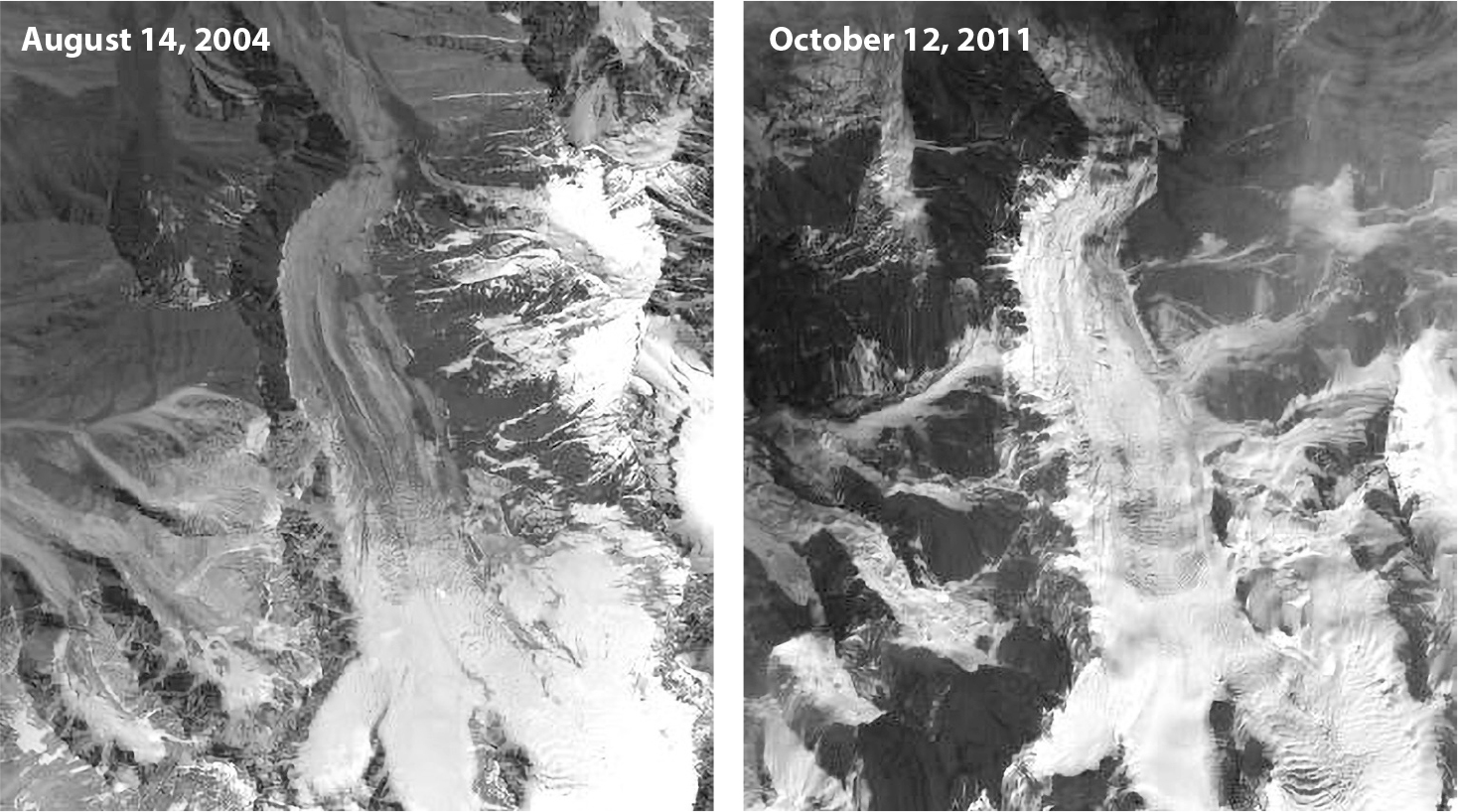
Figure 6. Two images of Glacier 102 in Afghanistan from the Global Fiducials Program. On the left was capture 8/14/2004, on the right 10/11/2011. The differences can be used to infer glacial flow. From: USGS Global Fiducials Library Data Access Portal – Image Gallery, https://gfl.usgs.gov/gallery_main.shtml?current=2. > High res figure
|
Tracking Sea Ice
As noted, the fiducials represent fixed points on Earth. As the program evolved, Untersteiner urged that sea ice fiducial collections of the Arctic Ocean should try “dynamic tasking,” that is, tracking the same ice floe as it moves over the course of the melt season. This significant engineering challenge was successfully met with the help of anchor buoys deployed by the US Geological Survey at various locations across the Arctic. Repeated imaging of the ice cover is guided by the GPS on the data buoy to help estimate travel direction and speed of the ice cover. Imagery thus referenced can reveal ice fracture patterns, sea ice ridge heights, ice cover percentages, melt ponds, and other variables (Wilson et al., 2012). Figure 7 shows some of the images of the changing characteristics of a moving ice floe.
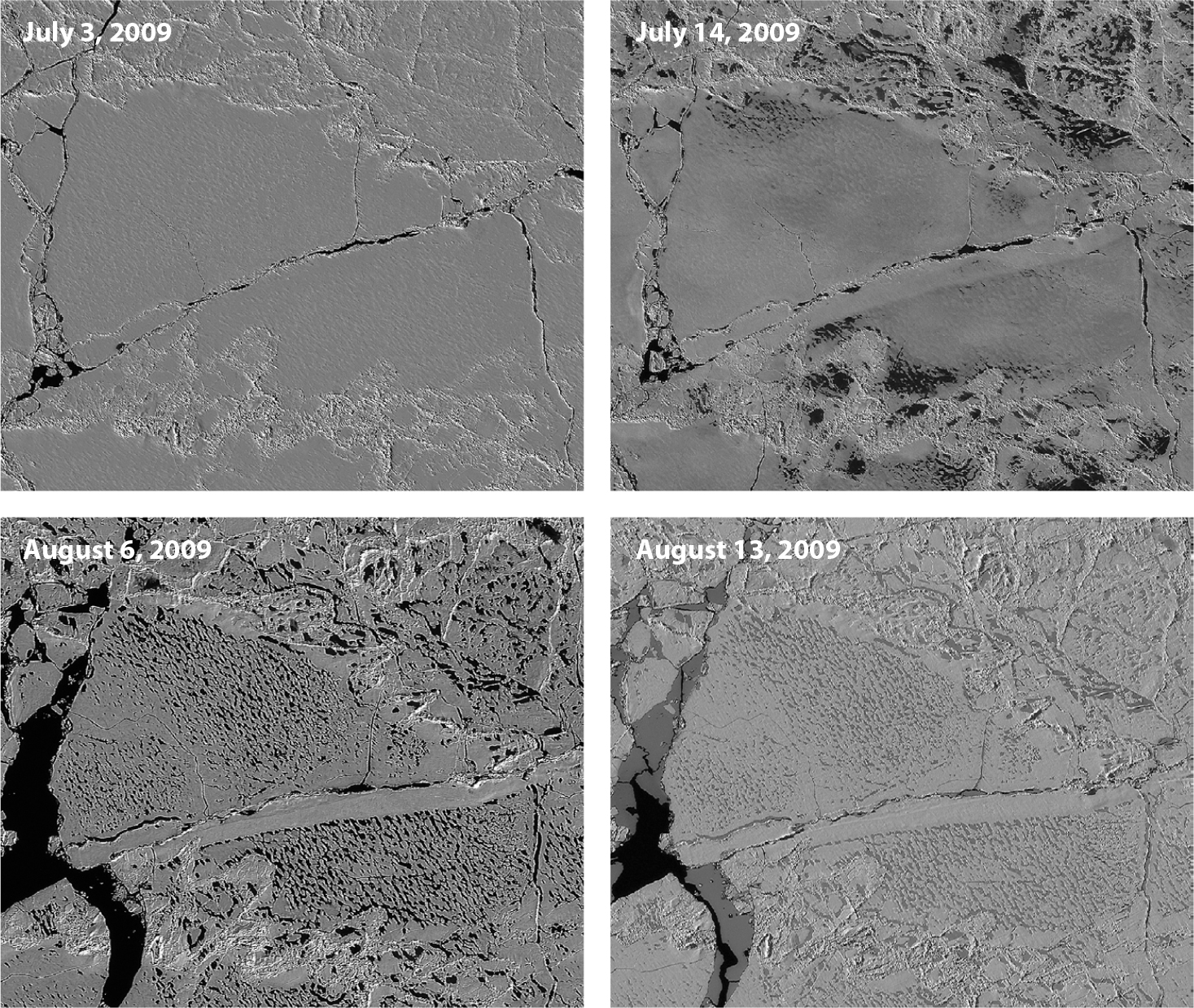
Figure 7. Development of melt ponds near USGS Arctic ice buoy 63541 in 2009 observed by tracking ice floes with high-resolution declassified LIDP images. Repeated imaging of the ice cover is guided by the GPS on the data buoy to help estimate travel direction and speed of the ice cover. Images from Zall (2012); see Kwok and Untersteiner (2011) for data analysis. > High res figure
|
Coastal Monitoring
Among the sites selected for coastal monitoring was East Timbalier Island, Louisiana, a barrier island in the Gulf of Mexico that is affected by sea level rise, subsidence, and changing land-use practices (Molnia et al., 2019). The imagery (e.g., see Figure 8) shows the changes caused by erosion, sediment restoration, and the impact of oil extraction. We note that the data can inform national security decision-making by showing how anthropogenic and natural processes are changing the landscape.
A FOCUS ON THE ARCTIC OCEAN
Throughout the Cold War, the Russian Arctic was strictly off limits to scientists from the West. But the end of the Cold War and the Clinton administration’s formal partnership with Russia led to new, and as it turns out, once-in-a-lifetime opportunities to share data. Through the Gore-Chernomyrdin Commission’s US-Russia Environmental Working Group (EWG), MEDEA was able to facilitate the development of a series of digital atlases that included Arctic data shared between the United States and Russia (Figure 9). The story of the US-Russia collaboration that led to the atlas is detailed with maps and photographs in the National Geographic article “An Arctic Breakthrough” (Belt, 1997).
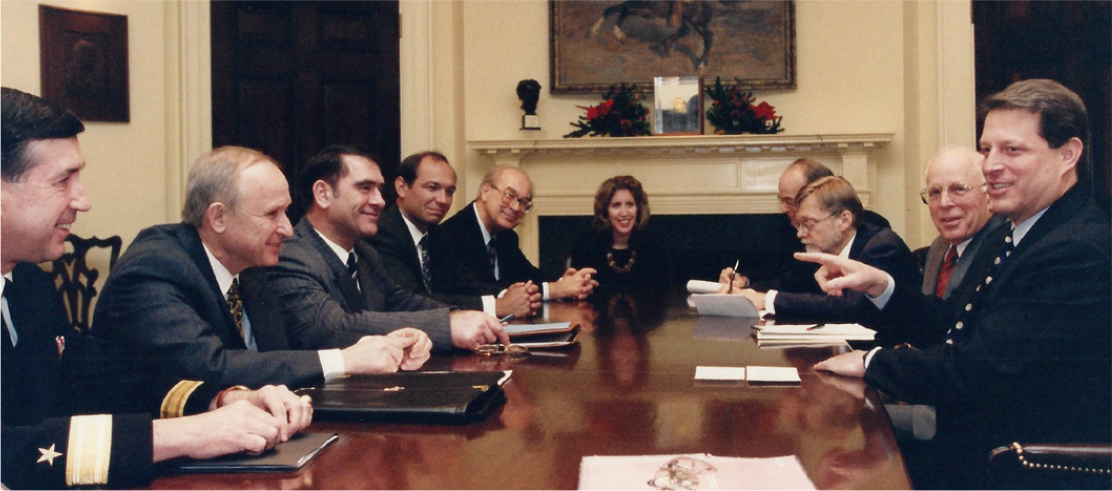
Figure 9. December 15, 1995, White House Meeting of US and Russian intelligence and defense officials with Vice President Al Gore to discuss the progress made on the Joint Arctic Oceanographic Atlases. From left: VADM Paul Gaffney, Russian General Georgiy Polishchuk, Russian Admiral Vyacheslav Solodov, Jeff Grant (National Reconnaissance Office), Russian Ambassador to the United States Yuli Vorontsov, Linda Zall (CIA), Rich Wilhelm (White House), D. James Baker (NOAA), Jack Gibbons (White House Science Advisor), and Vice President Al Gore. > High res figure
|
An early contribution of MEDEA to data release from Russia was the rescue of Sydney Levitus’s laptop with a set of Russian ocean data from the Arctic. As part of an earlier US-Russia data exchange program, Levitus, then Director of NOAA’s National Oceanographic Data Center (NODC), was stopped at Murmansk airport by Russian security agents who confiscated his laptop and other material (Helfferich, 1992). When the Gore-Chernomyrdin Commission’s EWG was established, Levitus brought this problem to the attention of author Baker, who convinced Gore to intervene with Chernomyrdin to get the data and laptop back. Chernomyrdin agreed and the full set of data was recovered, later to contribute to Levitus’s work on world ocean heat content and other properties (Levitus, 1994; Levitus et al., 2012).
Overall, the Russian polar data contribution consists of more than 1.4 million winter observations, data transcribed and digitized from 900,000 pages of documents at the Arctic and Antarctic Research Institute in St. Petersburg. The data included information on ocean circulation, salinity, temperature, potential density, sea ice, and meteorology (US-Russia Environmental Working Group, 1997). In fact, at that time, the Russian databases held 85% of all the world’s Arctic Ocean observations. This large amount of data was viewed as critical for understanding global climate change and assessing the hazards to the United States from migration of radioactive nuclides from Russian disposal sites. In fact, a later MEDEA report analyzed the details of munitions dumping in the Arctic and other ocean regions (MEDEA, 1997). When added to the existing US data and newly declassified data from the US Navy, this new data set more than doubled the amount of information that had been available to US scientists. Serreze et al. (2007) used these data to develop an accurate record that combines coastal station observations, data from drifting buoys, and Russian North Pole station data from 1950 to 1991 that were released as part of the MEDEA effort. The EWG subgroup on Arctic Climatology developed an electronic atlas of in situ Arctic Ocean data over a 40-year period, assembled from US, Russian, and Canadian data assets (Meade et al., 2001; Steele et al, 2001). Figure 10 shows where much of the data was collected. The atlas is available from the National Snow and Ice Data Center (https://nsidc.org/noaa/ewg).

Figure 10. (a) Russian data collection station locations. (b) US data collection locations. Note the complementary coverage. From Eos (1979). For more information on the Arctic Atlas, see Steele et al. (2001). > High res figure
|
Arctic oceanographers have long been interested in Arctic Ocean ice thickness and have emphasized the need for under-ice measurements as well as surface data. An early analysis by Rothrock et al. (1999) showed significant sea ice decline over the 40-year period from 1958 to 1997 (see Figure 11).

Figure 11. Mean ice draft, in meters, in various regions of the Arctic Ocean during the early submarine cruises of 1958–1976 and during the cruises in the 1990s. Data from Rothrock et al. (1999). > High res figure
|
In later work, with the data release area of declassified submarine sonar measurements covering about 38% of the Arctic Ocean, Kwok and Rothrock (2009) and Rothrock et al. (2008) were able to show that the overall mean ice thickness declined from 3.64 m to 1.89 m in the period from 1980 to 2008—a decrease of 1.75 m over 28 years.
Long-Term Variability of Arctic Ocean Waters
Swift et al. (2005) used data released under the US-Russian agreement to examine interannual to decadal variability of salinity and temperature in the Arctic Ocean from 1948 to 1993. Key questions related to the decline in sea ice, warmer water, and the mechanisms at work here. Using the Russian oceanographic database that had enough temporal and spatial coverage, they were able to show that beginning in 1976 most of the Arctic Ocean became significantly saltier, possibly related to the thinning of the ice cover. Most notable was the appearance of a pervasive, warming Atlantic layer throughout most of the Arctic Ocean from 1964 to 1969, possibly related to reduced vertical heat loss associated with increased upper layer ocean stratification.
The US-Russia Oceanographic Atlases have been extensively used over the past 25 years (e.g., see Boyd et al., 2002; Morison et al., 2002, 2012). The data from the atlases, when compared with data from the Scientific Ice Expeditions (SCICEX, 1995–1999; Morison et al., 1998) that came out of the same post-Cold War opening of Arctic science, told us how much the Arctic Ocean changed after 1989 (e.g., see Morison et al., 2000, 2012). The new information (Morison et al., 2000) led to the interagency Study of Environmental Arctic Change (SEARCH) program (e.g., see SEARCH, 2005) and its observational component, which became the US National Science Foundation’s (NSF’s) Arctic Observing Network, still an active program of the NSF Polar Programs Arctic Section.
Arctic Heat Budget – SHEBA Experiment
The combination of the importance of the Arctic sea ice cover to global climate and uncertainties about how to treat the sea ice cover in climate models led directly to the Surface Heat Budget of the Arctic (SHEBA) project, carried out during 1997–1998. SHEBA was aimed at understanding ice-albedo and cloud-radiation feedback mechanisms to improve the treatment of the Arctic in models (Perovich et al., 2003). MEDEA supported the SHEBA program by facilitating the release of imagery from US intelligence satellites to show detailed ice movement information during the experiment (see Figure 12).
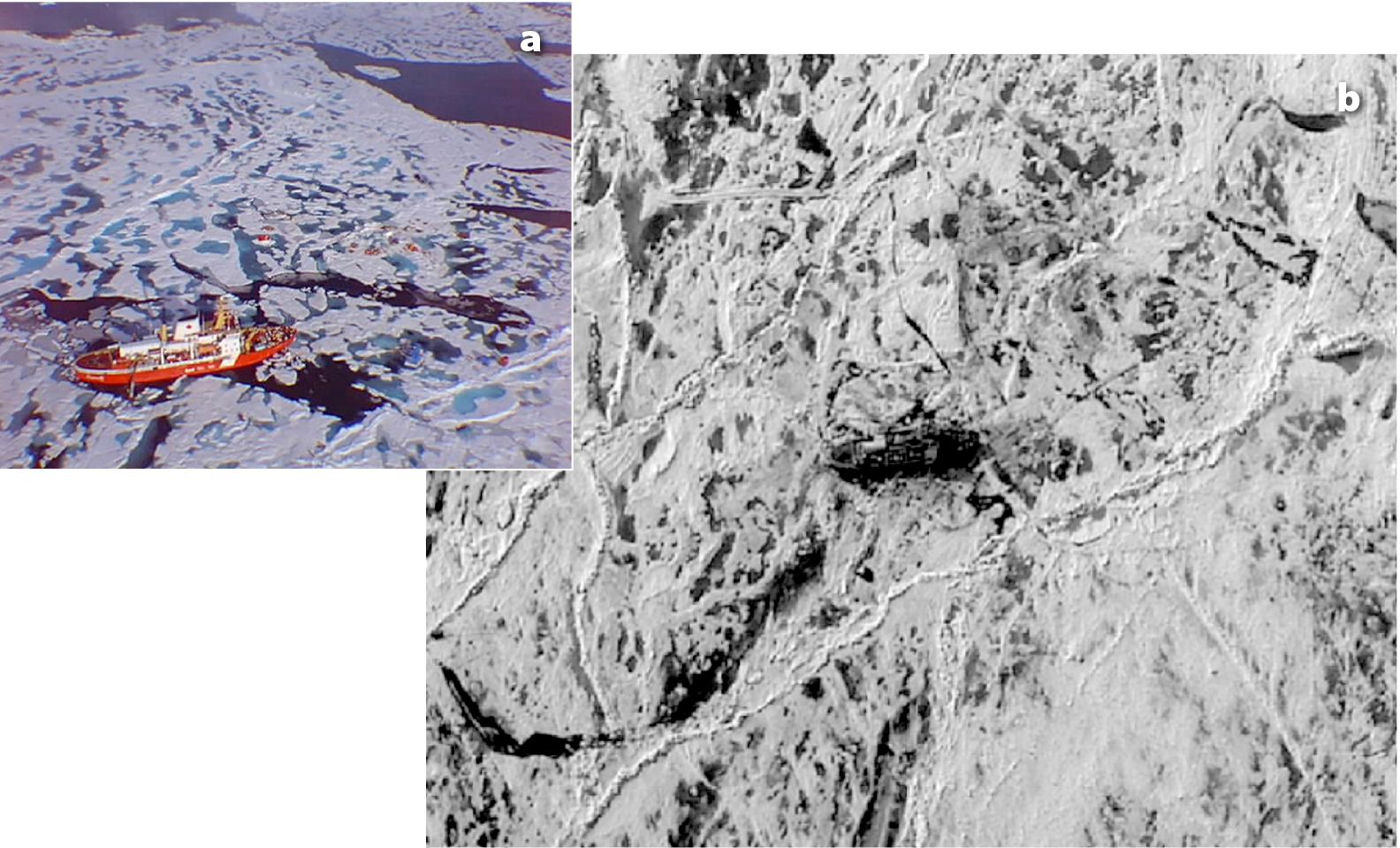
Figure 12. The SHEBA (Surface Heat Budget of the Arctic) Experiment was conducted in 1997–1998. (a) Canadian Icebreaker Des Groseillers in shifting ice. (b) High-resolution declassified LIDP image of experiment location. The dark area in the center of the image is Des Groseillers. Image from https://nsidc.org/data/g02180/versions/1. > High res figure
|
Arctic Surface Temperature with Gliders
The MEDEA program also supported the first-ever use of solar-powered wave gliders in the Arctic region to monitor changes in the Beaufort Sea. In 2011, during the ice-free late summer, the temperature sensors on two Arctic wave gliders monitored changes in the Mackenzie River discharge plume (Wood et al., 2013). About 900,000 discreet measurements covering more than 1,300 nautical miles (24,000 km) were returned in real time over the 55-day mission. These measurements complement the satellite sea surface temperature information from the Moderate Resolution Imaging Spectroradiometer (MODIS) instrument and have helped to develop a better understanding of sea surface temperature anomalies in Arctic marginal seas. In the autumn of 2011 and 2012, these anomalies were the largest observed in the Northern Hemisphere. Figure 13 shows the rapid heating of the Mackenzie River plume over three days in August 2011.
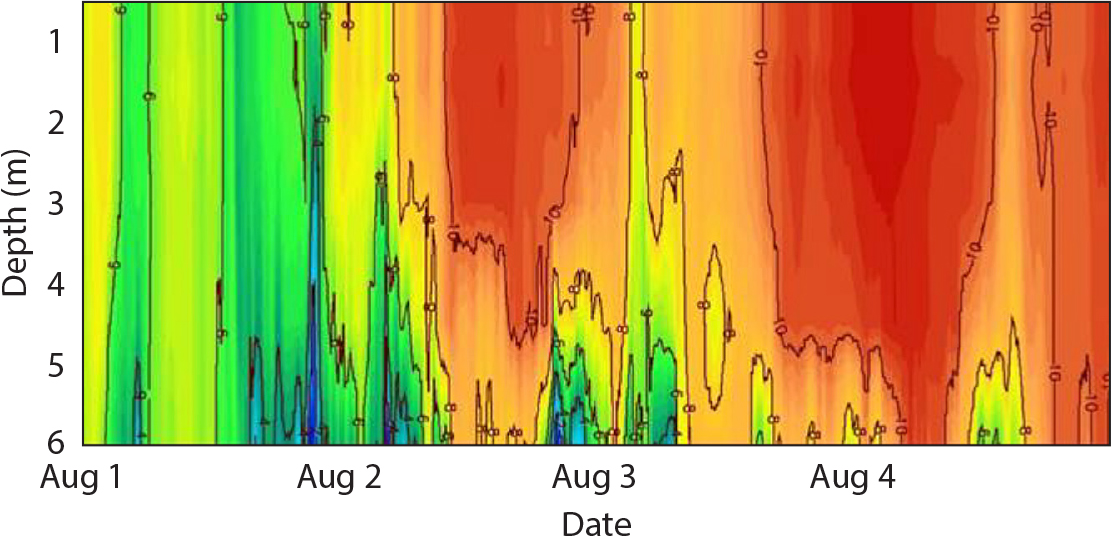
Figure 13. Arctic wave glider temperature section showing rapid heating of the Mackenzie River plume obtained August 1–4, 2011. These data were taken along the shoreward boundary of the plume at 147°W. After Wood et al. (2013). > High res figure
|
US NAVY GLOBAL DATA
It was recognized early on that the US Navy played a key role in collecting, analyzing, and archiving information about the ocean that was critical to determining processes and long-term trends. MEDEA sponsored two Navy panels (Figure 14) that issued reports focusing on the data’s utility and potential Navy contributions to ocean measurements for global change.
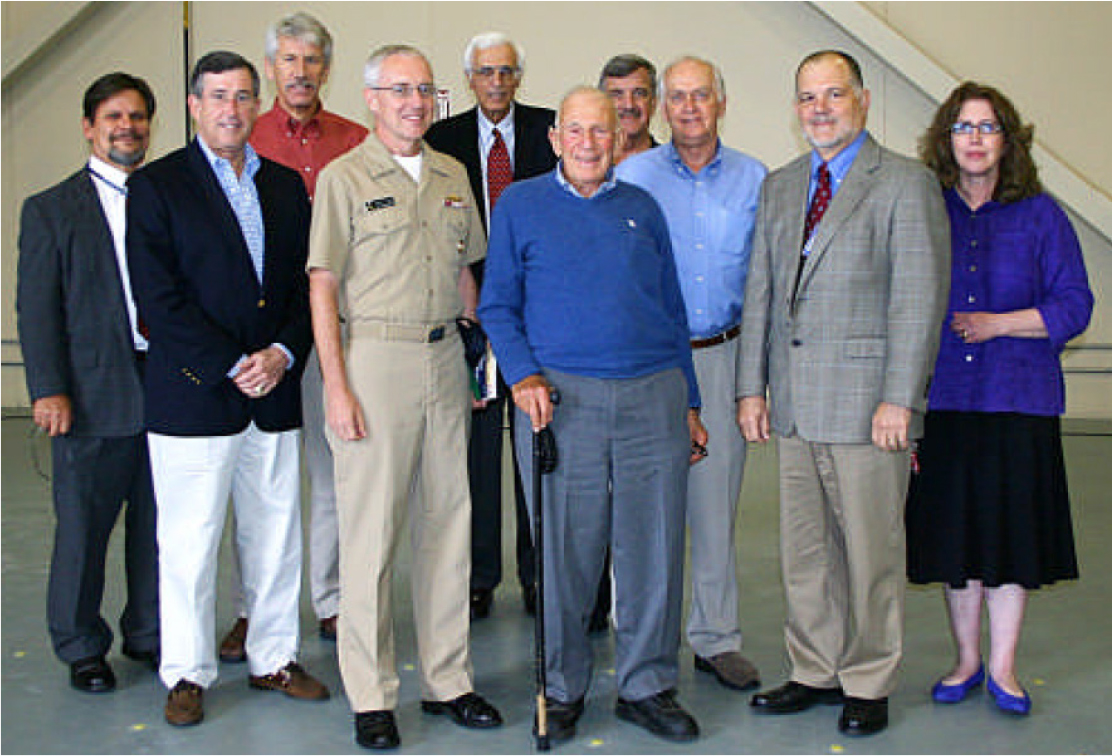
Figure 14. The second MEDEA Navy Panel met at the Naval Meteorology and Oceanography Command at Stennis Space Center, Mississippi, on August 18–19, 2009, to view Navy holdings. From left, Ed Gough, VADM Paul Gaffney, Bob Bindschadler, RADM Dave Titley, Bob Winokur, Walter Munk, John Orcutt, Peter Brewer, Otis Brown, and Linda Zall (Naval Meteorology and Oceanography Command, 2009). > High res figure
|
The first MEDEA Navy Report, “Scientific Utility of Naval Environmental Data,” (MEDEA, 1995), reviewed the Navy’s classified and otherwise unreleased data to determine their potential value for supporting research. The report concluded the Navy had a significant amount of oceanographic data that could potentially benefit the scientific community. It urged release of GEOdeticSATellite (GEOSAT) altimetry, marine gravity and bathymetry, geomagnetics, ice keel depth with acoustic data, ice morphology, seafloor sediments, real-time and archival salinity and temperature, and ocean optics and bioluminescence. The Navy supported the national civil need for data as the MEDEA report proposed and responded by declassifying some global data sets and releasing others, all of which were sent to the NODC. Referring to the Navy’s extensive data holdings from remote sensing and in situ measurements, archiving processes, and merging of measured and modeled data, MEDEA Navy Panel member Walter Munk wrote a letter to Vice President Gore saying that “I have just seen the crown jewels of global oceanography.”
The second MEDEA Navy report, “Climate and the Global Ocean: The Unique Contribution of U.S. Navy Systems and Capabilities to the Study of Global Climate Change” (MEDEA, 2011), concluded that US national security leadership should consider leveraging extant Navy ocean science, global ocean observational, and potential climate prediction capabilities to best inform the nation on climate trends.
Altimeter Data
The US Navy GEOSAT operated from 1985 to 1990, providing precise altimeter data, initially all classified. The first set of GEOSAT data declassified in 1990 covered the Southern Ocean from 60°–72° south latitude; then in 1992, the Navy declassified the data over all regions south of 30° south (https://www.globalsecurity.org/space/systems/geosat.htm). Oceanographers had been intrigued with the data from GEOSAT’s predecessor, SEASAT, and the altimeter coverage provided by ERS-1 and TOPEX/Poseidon, and wanted more. The altimeter data yield the topography of the ocean surface, which reflects the shape of the ocean floor as well as ocean currents. At MEDEA’s request, the Navy agreed to declassify the rest of the GEOSAT data, giving the first globally accurate view of the ocean floor in many remote areas, from 72° south to 72° north latitude. The data, now in the international GEBCO database, underpinned the development of the first detailed digital bathymetric map of the global ocean with a horizontal resolution of 1 to 12 km (Sandwell and Smith, 1997; see also Smith and Sandwell, 1997). The maps (Figures 15 and 16) showed features not previously known, such as the 1,600 km long Foundations Seamounts in the South Pacific.
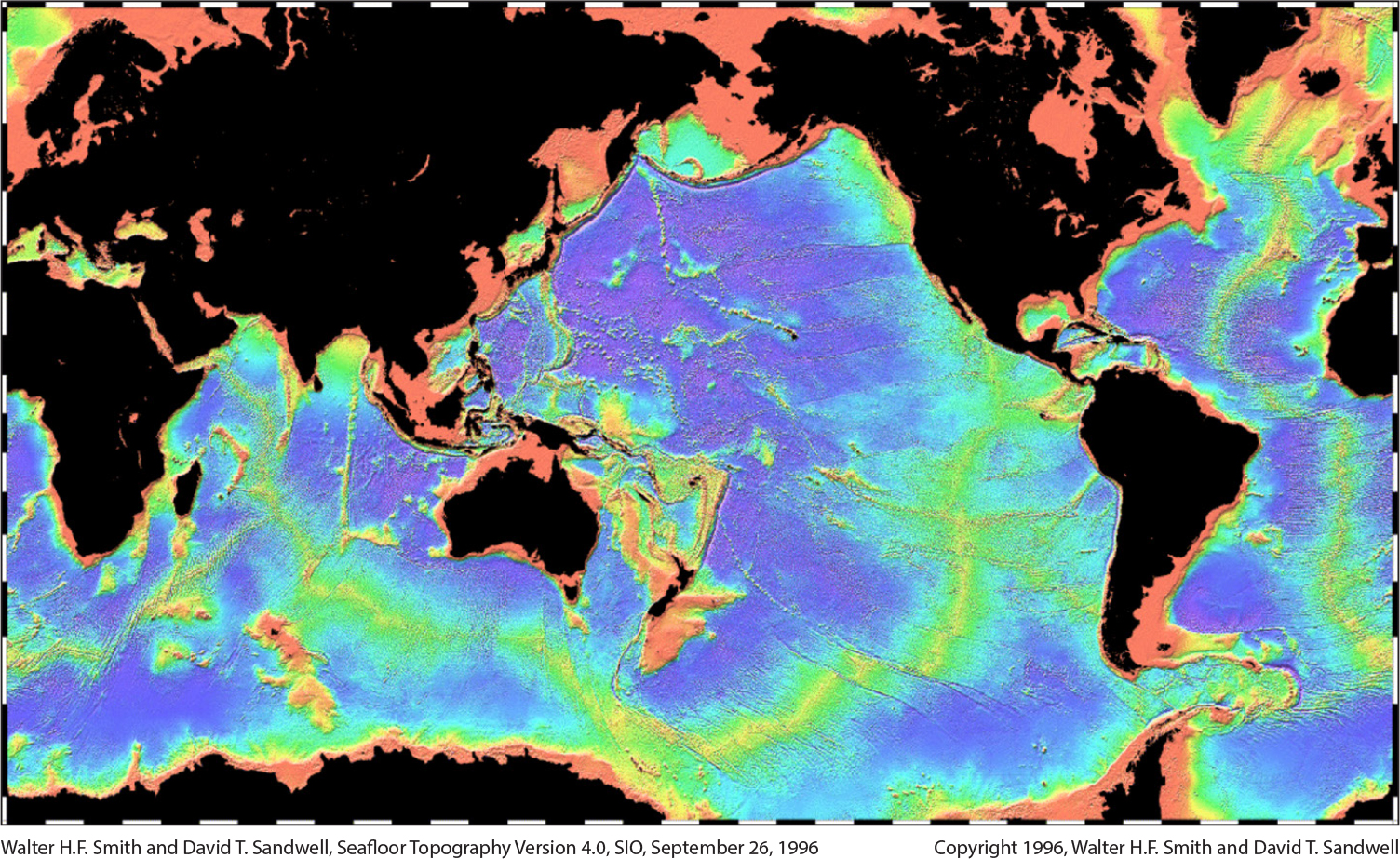
Figure 15. The first detailed digital map of ocean bottom topography. It was based on the Navy’s GEOSAT data, declassified at MEDEA’s request, along with shipborne measurements. This imagery, along with that in Figure 16, provided the first globally accurate views of the ocean floor in many remote areas, from 72° south to 72° north latitude. From https://www.ngdc.noaa.gov/mgg/image/global_topo_large.gif. See also Smith and Sandwell (1997). > High res figure
|
The transformation of geodesy with precise satellite altimetry is well known: In a personal comment to Baker, Marcia K. McNutt, now president of the US National Academy of Sciences, reported that: “In the early 1990s, before the release of the GEOSAT data, I was chief scientist on an expedition from Easter Island to New Zealand and in places the only ship tracks prior to ours were from the expedition of Captain Cook. Our best guide for the problems we were trying to unravel was the SEASAT data, but it was not of sufficient vertical and spatial resolution to give us what we needed. It would have been much simpler to sort out had the GEOSAT data been released earlier. We were honestly hunting in the dark.”
In Situ Data
MEDEA also determined that the US Navy had more than what constituted 100 “ship-years” of oceanographic holdings that could improve understanding of global climate change. This amounted to approximately six million in situ oceanographic observations from the Navy’s Global Oceanographic Observation Data Set (GOODS) and seafloor sediment data (Figure 17). Data released to the NODC included ice depth, ice shape, ocean depth, sediment composition, sea surface height, salinity, seabed magnetics, water temperature, bioluminescence, and light transmissibility. In fact, the Naval Oceanographic Office (NAVOCEANO) continues to supply NOAA with Public Release Ocean Observations under the MEDEA agreement. Traditionally, it has been once a year and approximately 3,000 profiles/year.
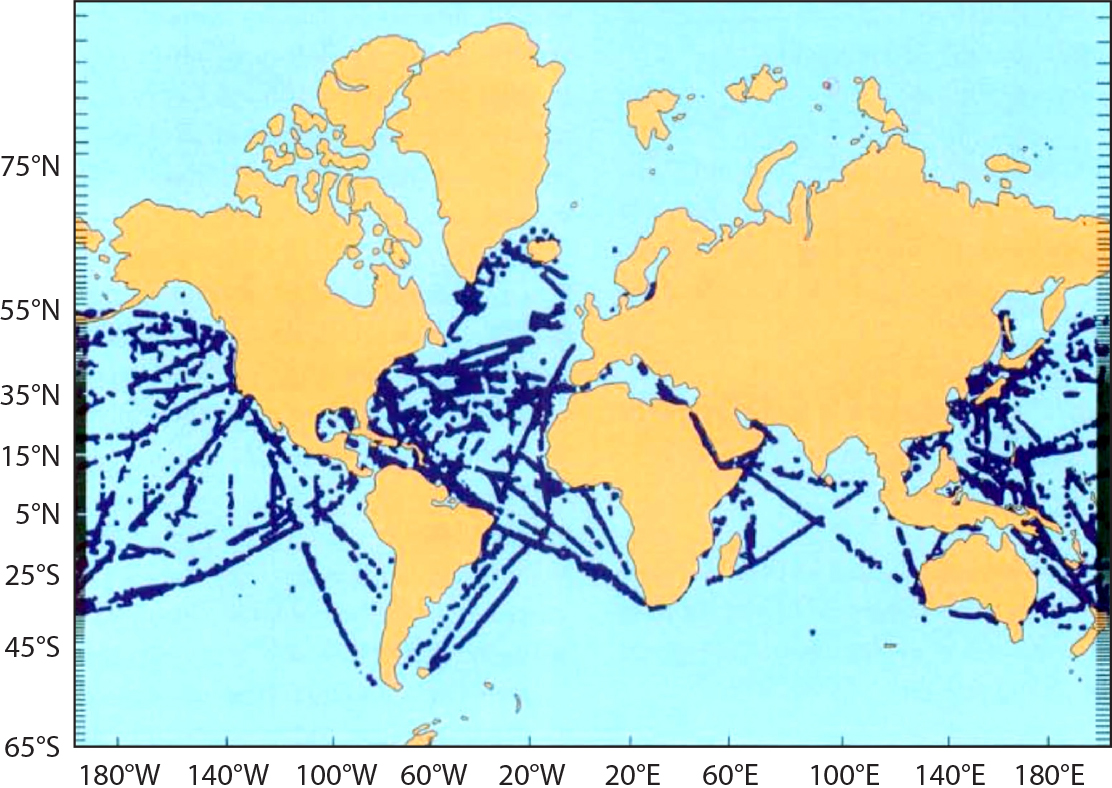
Figure 17. Locations at which measurements for the Navy’s Global Oceanographic Observation Data Set (GOODS) were collected during the period June–October 1994 (MEDEA, 1995) > High res figure
|
In addition to the global data released, regional data came from areas where the Navy focused its operations, for example, in the Persian Gulf, as Figure 18 shows. It is important to remember that the civilian community has no global or regional digital database of seafloor sediment properties that approaches this level of detail.
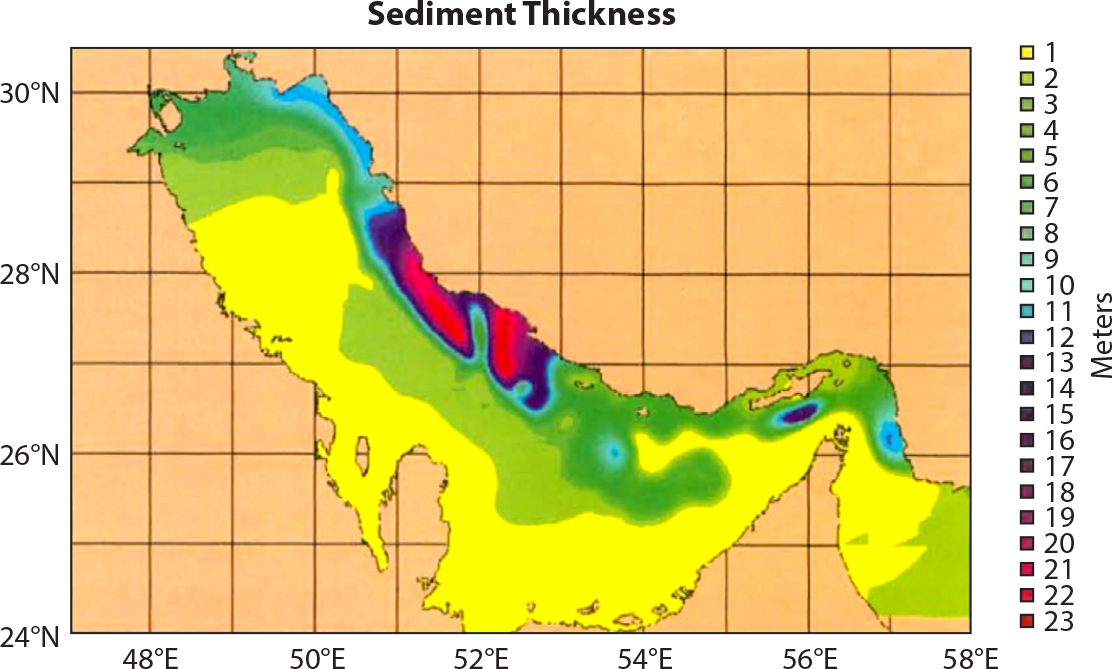
Figure 18. Sediment thickness in the Persian Gulf from Navy data set (MEDEA, 1995). > High res figure
|
WILDFIRES, GDIN, AND LESSONS FOR FUTURE
During the first MEDEA period, the focus of the program was heavily technical—getting the data out and showing how they could be used and establishing the Global Fiducials Program. During the second MEDEA period, there was an increasing focus on the use of those data both for better understanding of the science and for national security and societal issues. The new data reinforced the growing evidence of global climate change, particularly in the Arctic and with melting glaciers. MEDEA also provided data on the 1994 Russian Komi Oil spill and on extreme weather events, for example, with analysis support for both the upper Midwest flooding of March–May 1997 and Hurricane Mitch in 1998, the second-deadliest Atlantic hurricane on record.
Wildfires
One of the important outcomes of MEDEA’s work came from Ralph Cicerone’s suggestion in 1992 during the ETF that the US missile launch warning satellites (part of the Defense Support Program), which carry high-resolution infrared sensors, could be used to detect wildfires before they spread too widely. A series of controlled wildfires validated this detection, and MEDEA later confirmed that the geosynchronous Overhead Persistent Infrared satellites used to monitor missile activity (e.g., see https://www.globalsecurity.org/space/systems/opir.htm) improved the estimate of the numbers and extents of fires by about 20% over the civilian assets traditionally used. The information was used most recently in 2019 when California Governor Gavin Newsom announced that the Pentagon agreed to provide information from existing Cold War era military satellites to spot brush fires on the ground (Figure 19). The Pentagon has agreed to work with the State of California to make this information available during upcoming fire seasons.
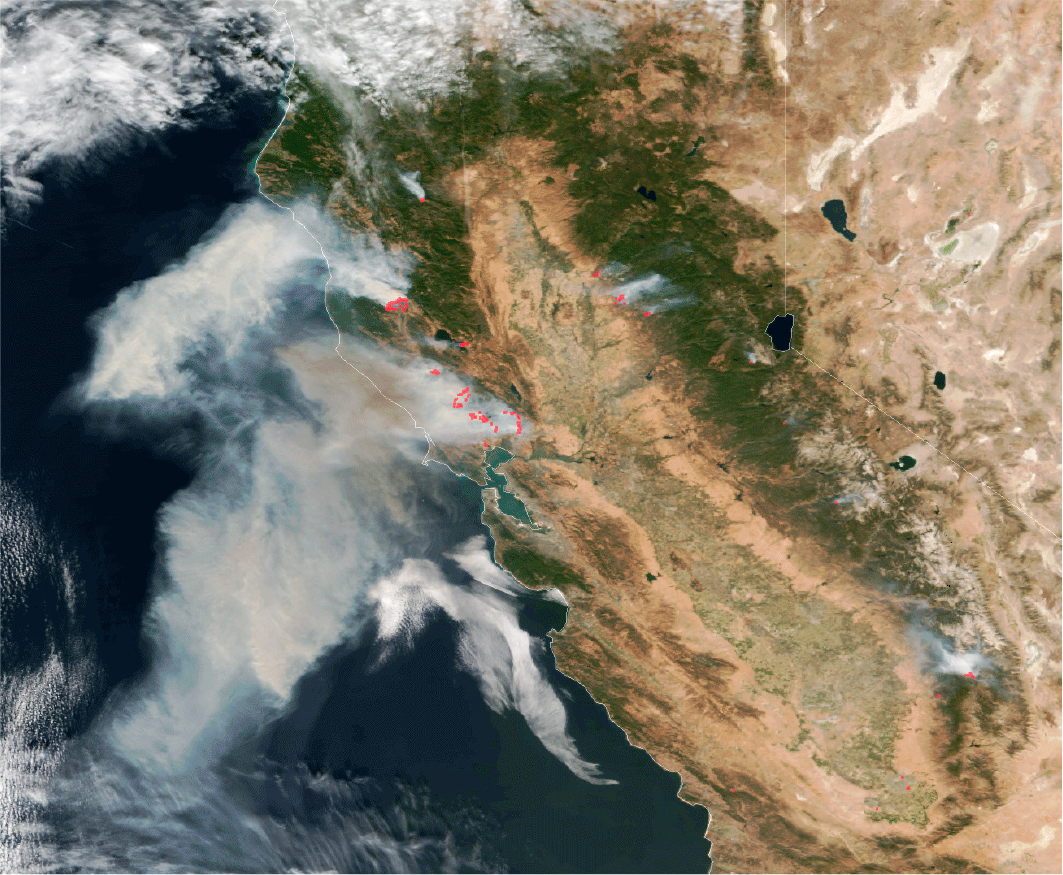
Figure 19. California fires as seen from NOAA geostationary satellite GOES in 2019. Image credit: NOAA National Environmental Satellite, Data, and Information Service (NESDIS). > High res figure
|
GDIN
Recognizing the danger of increasing greenhouse gases and associated extreme weather, a significant contribution of MEDEA was to lay the foundation for a Global Disaster Information Network (GDIN, 1997). The GDIN was formally established by Executive Order on April 17, 2000 (Clinton, 2000) but was not supported by subsequent administrations (see https://1997-2001.state.gov/issues/relief/gdin.html). Subsequent continuing evidence of global climate change shows that the rationale for such a network is even more valid today.
Lessons for the Future
In addition to facilitating the release of classified data, the MEDEA program supported several forward-looking reports on monitoring and impacts of global climate change. For example, a National Academy study (NRC, 2010b) on verifying greenhouse gas emissions emphasized that current methods were not sufficiently accurate to check self-reported country estimates against independent data (e.g., remote sensing, atmospheric measurements) or to estimate other greenhouse gas emissions. The report gave an estimate of what strategic investments would be required to improve reporting and develop a useful capability for independent verification of greenhouse gas emissions. For measuring CO2 in urban areas, important for treaty compliance monitoring, funding from MEDEA helped to jump-start the urban measurements of greenhouse gases (McKain et al., 2012). A comprehensive report outlined the impacts expected over the next decade from climate extremes (McElroy and Baker, 2012).
As the MEDEA program evolved, so did civil and private sector satellite and in situ measurement capability. Today, ESA, NASA, NOAA, and other government programs are providing a comprehensive suite of Earth data, complemented by fleets of high-resolution private-sector systems. The proliferation of small satellites with tailored sensors is providing much new information about land, ocean, and ice (e.g., see Kwok, 2018).
And the evidence for global climate change has grown stronger. When MEDEA began, the Intergovernmental Panel on Climate Change (IPCC) First Assessment Report (1990, p. 53) noted that “the unequivocal detection of the enhanced greenhouse effect from observations is not likely for a decade or more.” But over the next two decades, the global data from MEDEA and other programs reinforced the picture of an increasingly warming world, with dangerous societal impacts. “The Warning,” a 2016 film about MEDEA directed by Paul Jenkins, emphasized this point. By 2013, the IPCC, considering all this new knowledge, had evolved to a new position: “It is extremely likely (95% chance) that human influence has been the dominant cause of the observed warming since the mid-20th century.” (IPCC, 2013, p. 17). Recent data continue to confirm that assessment.
The MEDEA program and the continued use of the classified data that have been released was an important step in dual-use technology for societal benefit. The MEDEA data and MEDEA-supported research studies made a discernible difference in our understanding of the world, and the Global Fiducials Program is still making an important contribution. The effort showed that national security systems acting in concert with civil and commercial remote-sensing systems and in situ measurements can significantly improve collection of those critical parameters necessary to understand and manage global climate change and other key environmental issues.
ACKNOWLEDGMENTS
We thank Michael McElroy, Jeff Dozier, John Orcutt, Paul Gaffney, Robert Bindschadler, Peter Brewer, Otis Brown, Ron Kwok, Marcia McNutt, Jamie Morison, David Sandwell, and Robert Winokur for valuable input.

